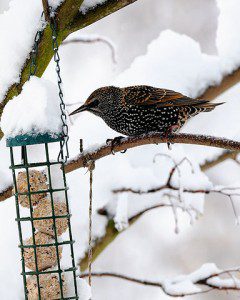Can You Keep Starling Flocks Off of Bird Feeders?
By Chris Williams on March 7, 2016.
At our house, we love to feed birds and have a couple of large feeders in the backyard. In the last couple of weeks, we have had large flocks of starlings mobbing the feeders, scattering seed and keeping the other birds away. Is there any way to scare them off and keep them away? Loud noises don’t seem to work for long. N. R., Barrington, NH

Starling
Unfortunately, there is not much you can do to deter starling flocks on an individual backyard basis. The solution is to remove the food source but I can understand that you don’t want to do that. Platform feeders with loose seed and any feeder that drops seed are the most desirable to starlings. Use a catch tray under feeders to limit the amount that ends up on the ground. You can also try caged feeders that allow small birds through the outer cage to reach the seed cylinder inside, but starlings can’t fit through the openings. A temporary removal or relocation of your bird feeders may be enough to convince the birds that the food stop in your yard is not worth it.
Winter Starling Flocks Are Daunting
Large winter starling flocks are common, if somewhat startling. Starlings come together to form large flocks in late summer to early fall. Their feeding habits change in winter from mostly insects to grains and seeds. They can be a real problem in areas where they all roost together at night since winter flocks can contain more than a million noisy, pooping birds. A so-called winter starling flock is rarely just starlings. These multi-species “blackbird” flocks are made up also of grackles, red-winged blackbirds, brown-headed cowbirds, and sometimes even robins.
The bad news is that starlings tend to return to the same feeding areas day after day, so once they discover bird feeders you can expect to see them again. They don’t roost in the same areas where they feed and can travel great distances each day to reach feeding grounds. Each evening, the flock returns to the roosting area (see Noisy and Messy Starling Winter Roosts). Many communities or city parks, when faced with huge roosting blackbird flocks, attempt to move them out with noisemaking or harassment programs, usually with little success.
Starlings Outcompete Other Birds for Nest Sites, Too
During breeding season (April – May), starling flocks are at their smallest size. Around homes, nesting starlings can be a nuisance as they choose to nest in manmade cavities such as dryer vents, holes in roof soffits, or openings in gutters (see Starlings Will Nest in Homes). They outcompete native cavity-nesting birds such as bluebirds, finches, woodpeckers, and wrens for available nest openings. Starlings are one of the few birds that are not protected by federal law so nests on structures can be destroyed and nesting birds removed.
We can do something about starlings that are nesting in homes or on store signs, or that are roosting in smaller numbers on building ledges – but large winter flocks are beyond anyone’s control.
Photo Credit : “Sturnus vulgaris -England -bird feeder-8” | CC BY 2.0 via Wikimedia Commons.